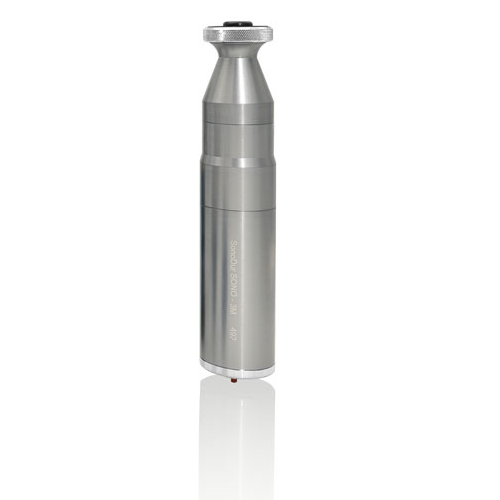Our motorized measuring probes can be used with both the SONODUR 3 mobile hardness tester and the SONODUR R, which was developed for fully automatic production.
The intelligent measuring system of each probe covers the entire hardness range of the classic Vickers scale. Motor measuring probes operate with significantly lower test forces than hand-held probes, making them particularly suitable for sensitive surfaces on which only minimal test indentations are to be made. The field of application includes thin, sensitive surface layers such as in the printing industry, for pistons and plating as well as sensitive components/materials or the measurement of surface hardness in the copper gravure printing industry or the automotive industry.
Our probes work according to the UCI hardness testing method. Here, the probe rod is excited to oscillate in the longitudinal direction with its natural frequency. At the lower end, there is a Vickers diamond which is pressed into the material to be tested. A defined load is applied via a spring system. When the Vickers diamond penetrates the specimen, this vibration is damped and a frequency shift occurs, which can be measured. From this frequency shift, we calculate the hardness value using the Vickers scale after the nominal test force has been reached with the final position of the motor and after the programmed penetration time has elapsed.
The main difference in the procedure compared to the classical Vickers hardness test is, among other things, that the contact area of the Vickers diamond is responsible for the frequency shift of the vibrating rod. In contrast, in classical hardness testing, the indentation of the diamond must be measured optically.
Advantages:
- High reproducibility of the measured values: Almost constant, low scatter of the measured values even at high hardness for high-quality measurements
- A test procedure similar to the classic Vickers test: constant test load
- Maximum variability and flexibility: manual, semiautomatic or fully automatic measurements possible
- Conserve resources by minimizing test indentation: The method can be considered as low-destructive
- Small, handy test probes: Optimal access to the test positions to be measured
- Cost-saving: No need to destroy the component to be measured
- Mobile hardness testing on site
– During incoming goods inspection
– During production
– On already installed production parts in the field
- Easy to automate: Operator-independent measurements for even higher reproducibility of measured values
- Standardized test method: UCI method – Our expertise for your safety


